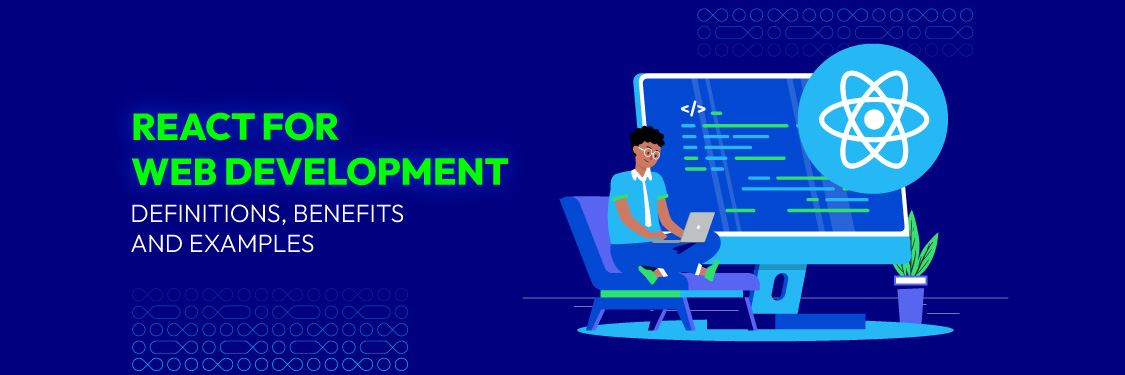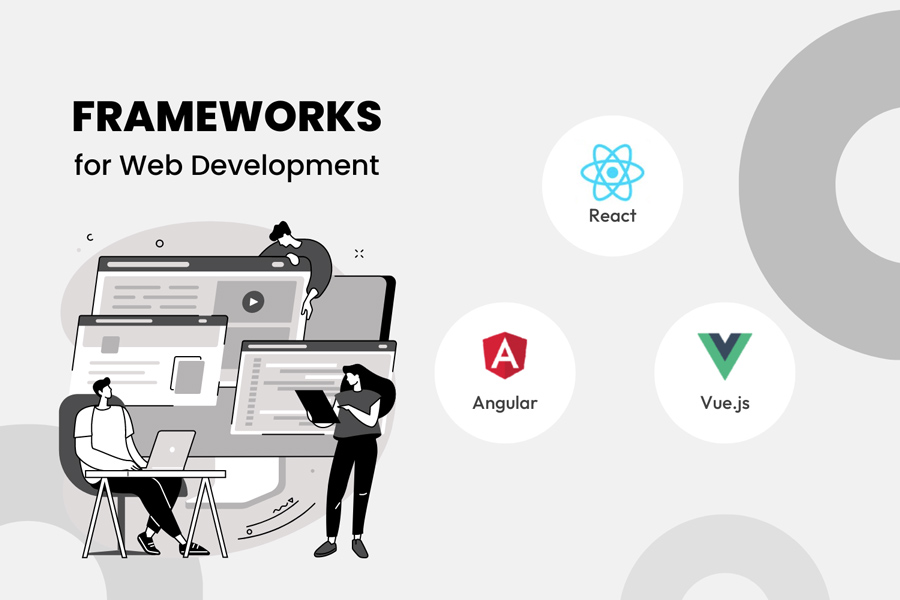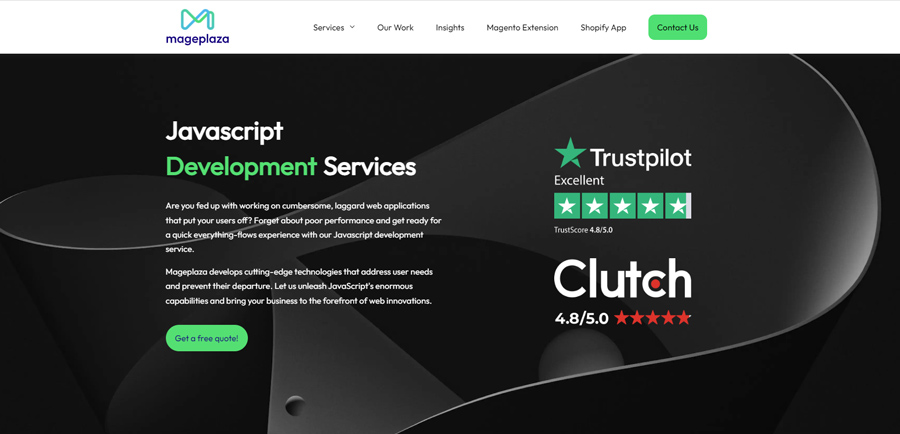React For Web Development: Definitions, Benefits and Examples
Summer Nguyen | 08-23-2024

What do Facebook, Instagram, Netflix, and Airbnb all have in common? They all use React, a JavaScript library that has taken the development world. In 2023 alone, React was one of the most used web technologies with 40.6% market share, proving its dominance in the industry.
But what exactly is React, and why is it so widely adopted? Come along as we dive into the details of this versatile library and discover why it’s the secret weapon behind some of the most popular web applications on the planet.
What is React In Web Development?
React is a well-known JavaScript library used for front-end web development. React helps developers create complex user interfaces by dividing them into smaller, reusable pieces called components. This approach makes it easier to handle and update large applications, promotes reusing code, and leads to a more efficient development process.

When it comes to React, you might get confused by terms like React, ReactJS, and React Native. Let’s quickly clarify the differences between them!
- React: This is the core JavaScript library used for developing user interfaces (UIs) for web applications.
- ReactJS: This is often used interchangeably with “React,” but technically refers to the specific use of React for building web apps.
- React Native: This is a framework built on top of React, specifically designed for creating mobile apps (for iOS and Android).
Key takeaways:
- React is the core library.
- ReactJS uses React for web development.
- React Native uses React for mobile app development.
In this article, we will explore React in general. Now, let’s explore the key features of React:
- Component-Based Architecture: React breaks down the UI into small, reusable components. Each handles its own part of the UI and can easily be used to build bigger, more complex interfaces.
- Virtual DOM: React uses a Virtual DOM to improve performance. Rather than altering the actual DOM directly, React initially updates a virtual version of the DOM, then efficiently reconciles the changes, reducing the impact on performance and providing a seamless user experience.
- Declarative Syntax: React allows developers to define the appearance of the user interface according to the app’s current state. This makes the code easier to read and fix when something goes wrong.
- Unidirectional Data Flow: In React, data moves in a single direction, flowing from parent components down to child components. This simplifies the management of the state and makes it easier to understand how data changes affect the UI.
- Rich Ecosystem and Community: React has a wide range of tools, libraries, and community support. This includes popular additions like React Router for routing and Redux for state management.
Why Should You Use React For Web Development?
React offers several advantages for web development, making it popular with website owners and developers. Let’s explore why many people use React for web development:
- Easy to Build and Maintain: React’s component-based design enables you to break down the user interface into smaller, manageable pieces. This makes it easy to develop, update, and maintain complex applications.
- Fast Performance: React’s Virtual DOM speeds up updates by only changing parts of the page that need it, rather than reloading the whole page. This makes websites load faster, providing a smoother user experience.
- Reusable Components: With React, you can build reusable components that can be used across different parts of an application or even in different projects. This saves time and effort, keeps your code consistent.
- Clear Code Structure: React’s declarative syntax lets you describe how your app should look based on its state, making your code easier to read, understand, and debug.
- Better SEO: React supports server-side rendering, which helps search engines find and index your site more effectively, improving your online visibility.
- Strong Community and Tools: React has a large community and many useful tools, libraries, and resources. This support helps solve problems faster and integrates with other technologies easily.
- Scalable Growth: React can handle growing amounts of traffic and features, so your website can expand with your business.
Using React can make your web development projects more efficient, scalable, and easier to manage.
How To Use React For Web Development?
Step 1. Plan Your Project
Before you start building with React, it’s essential to have a clear idea of what you want to create. Outline the goals of your project, such as the type of website or app you need, its main features, and its overall design.
Moreover, consider aspects like user interactions, content layout, and any specific functionalities you want to include. This planning stage will give you a roadmap and help you make informed decisions as you proceed.
Step 2. Set Up A Staging Environment
To get started with React, you need to set up your development environment on your computer.
- Install Node.js: Node.js is a tool for running React on your computer. You can install this tool from the official website.
- Install a Code Editor: A code editor is where you’ll write your code. Popular choices include Visual Studio Code or Sublime Text.

Step 3. Create A New React Project
Once your development environment is set up, you can create a new React project using a tool called Create React App. This tool sets up all the necessary files and configurations for a React project automatically.
Next, open your code editor and use a simple command to generate a new project folder with everything you need to start coding. This step simplifies the initial setup and allows you to focus on building your website.
Step 4. Build Your Components
React uses a component-based approach, meaning you will create small, reusable pieces of your website, known as components. For example, you might have separate components for a header, a footer, and a main content area. Each component can be designed and coded independently, then combined to form your complete website. React’s component structure simplifies the management and updating of different parts of your site.
Step 5. Style Your Components
After building your components, it’s time to add style to make your website visually appealing. Use CSS (Cascading Style Sheets) to apply colors, fonts, and layouts to your components. You can create separate CSS files for each component or use inline styles. Styling helps ensure your website matches your design vision and provides a pleasant user experience.
Step 6. Test Your Website
Before launching your website, it’s important to test it thoroughly. Check that all features work as expected and that the site looks good on various devices, such as smartphones, tablets, and computers.
Testing helps identify issues or bugs that need fixing and ensures that your website provides a smooth and reliable user experience.
Step 7. Deploy Your Website
Once you’re satisfied with your website, it’s time to make it available to the public. Deploying involves uploading your website files to a hosting service, which makes your site accessible online.
Based on your requirements, choose a hosting provider and follow their instructions to upload your project. After deployment, you can share your website’s URL with others and start attracting visitors.

Step 8. Maintain and Update
Maintaining your website is an ongoing process. Check for updates regularly, fix any issues, and add new features as needed. React makes it easy to update your site with new content or improvements. Keeping your website up-to-date ensures it remains relevant and continues to provide a great experience for your users.
When Should You Use React For Web Development?
Many developers choose React, but do you know when this framework is most effective? Let’s explore the scenarios where React is the ideal choice for web development!
- Single-Page Applications (SPAs): If you’re developing a single-page application where the content changes dynamically without reloading the whole page, React is a great choice due to its fast performance and component-based structure.
- Complex User Interfaces (UIs): If your app involves many interactive elements, data visualizations, or frequent updates, React’s component structure helps manage complexity.
- Projects Requiring High Performance: React’s Virtual DOM efficiently updates only the necessary parts of the page, leading to a smooth user experience.
- Projects Where Code Reusability is Key: React’s component-based design allows you to easily reuse UI elements across your application, reducing development time and effort.
If your project fits any of these descriptions, React could be the perfect tool to streamline your web development process.
The Limitations Of React In Web Development
While React offers many benefits, it also has some limitations:
- Learning Curve: React can be hard to learn for beginners because of its complex ideas like JSX and how components work. It may take extra time to get used to these concepts, which can slow down the development process.
- Frequent Updates: React gets updated often, which might cause problems if you need to keep your code compatible with the latest version. You may need to adjust or rewrite parts of your code to keep everything working smoothly.
- SEO Challenges: Even though React can work with server-side rendering, making sure your site ranks well on search engines can be trickier than with regular static websites. You might need extra tools and setup to assist search engines in discovering and indexing your content.
- Complex State Management: Managing data in large React apps can get complicated and might need extra tools like Redux. Without good state management, it can be hard to keep track of and fix issues with your app’s data.
By understanding these limitations, you decide if React is the right choice for your project and prepare for any potential challenges.
Real-world Examples of React For Web Development
React is used by many well-known companies and websites for various purposes. Here are some real-world examples of how React is utilized in web development:
- Use: Facebook, the creator of React, uses it extensively across its platform. React helps manage dynamic content, user interactions, and the complex UI of its website and mobile apps.
- Example: Features like the news feed and interactive comments use React to provide a seamless user experience.
Netflix
- Use: Netflix uses React on its platform to manage the complex user interface of its streaming service. React helps in providing a smooth browsing experience.
- Example: The Netflix interface, including the search functionality and content recommendations, is built with React.
- Use: Reddit uses React to manage its web interface, providing a more interactive and engaging experience for users.
- Example: User feeds, comment sections, and upvote/downvote buttons are implemented using React.
These examples highlight how major companies use React to develop complex, dynamic, and high-performance web applications, demonstrating its effectiveness and versatility in real-world scenarios.
FAQ Section
Is React suitable for beginners?
React can be challenging for beginners due to its unique concepts like JSX (JavaScript XML) and component lifecycle. However, many find it approachable once they get past the initial learning curve. Plenty of tutorials and resources are available that can help newcomers understand and use React effectively.
Is React only for large-scale applications?
No, React is not just for large-scale applications. While it excels in managing complex user interfaces, it is also suitable for smaller projects and simple websites. Its component-based architecture allows for scalability, but you can begin with small projects and grow as needed.
Can I use React with my existing website?
Yes, you can integrate React into an existing website. You can use React to add interactive elements or build new parts of your site without needing to rebuild everything from scratch. This makes it a flexible option for improving or updating your current website.
Is React enough for web development?
React is a powerful library for creating user interfaces, but it is often used in combination with other tools and libraries to handle additional tasks like state management (e.g., Redux) or routing (e.g., React Router). While React handles the view layer well, you may need other technologies to complete a full web development project.
How does React compare to other frameworks like Angular or Vue?
Here are the differences between React, Angular, and Vue in a way that’s easy to understand:
| Feature | React | Angular | Vue |
|---|---|---|---|
| Learning Curve | Moderate (easier than Angular) | Steep (more complex concepts) | Gentle (easiest to pick up) |
| Flexibility | High (lots of freedom and choices) | Medium (more structured approach) | High (adaptable to different needs) |
| Community | Huge (tons of support and resources) | Large (well-established) | Growing (enthusiastic community) |
| Best For | Dynamic UIs, SPAs, large projects | Enterprise apps, complex projects | Flexible projects, small teams |
| Key Advantage | Component-based, great performance | Full-featured framework | Easy to learn, versatile |
| Potential Drawback | Requires more setup decisions | Can feel overwhelming for beginners | Less opinionated structure |
React, Angular, and Vue are all popular tools for web development, but they have different strengths:
- React: Known for its flexibility and component-based architecture, it focuses on building user interfaces and allows for easy integration with other tools.
- Angular: A full-fledged framework that provides a comprehensive solution for building web applications, including built-in tools for routing, form handling, and HTTP requests.
- Vue: Offers a balance between React’s flexibility and Angular’s comprehensive features, with a simpler learning curve and a focus on ease of integration and development.

Each has its own strengths and is suited to different needs, so the best choice depends on your project requirements and team preferences.
Get React Web Development Support from Experts
As React is a widely-used JavaScript library designed for building user interfaces, it fits seamlessly into our comprehensive JavaScript Development Services. Our skilled developers have extensive knowledge of various JavaScript technologies, including React, to ensure your web projects are built with the latest trends and best practices. Whether you need to create a new application from scratch or enhance an existing one, we provide tailored solutions to meet your needs.

Ready to take your web development to the next level? Explore our service to learn more about how we can assist you and make your vision a reality.
REACH OUT TO US
Conclusion
In conclusion, React for web development offers a powerful solution for creating dynamic, efficient, and scalable user interfaces. Its component-based architecture simplifies the development process, allowing for reusable code and smooth updates. React’s strengths in managing complex applications, its flexibility, and its strong community support make it a popular choice among developers.
Whether you’re handling a small project or a large-scale application, React can enhance performance and improve user experience. As you consider your options for web development, React stands out as a robust tool that can meet diverse needs and help you build modern, interactive websites.





